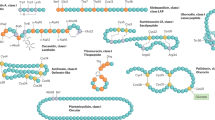Abstract
IN a communication under the above title, Giri1 describes the use of a starch agar gel for the location of amylases on the paper chromatogram. The technique seems to be essentially the same as that used in this Department, and previously described in Nature2.
This is a preview of subscription content, access via your institution
Access options
Subscribe to this journal
Receive 51 print issues and online access
$199.00 per year
only $3.90 per issue
Buy this article
- Purchase on Springer Link
- Instant access to full article PDF
Prices may be subject to local taxes which are calculated during checkout
Similar content being viewed by others
References
Giri, K. V., Nature, 167, 859 (1951).
Reid, W. W., Nature, 166, 569 (1950).
Mitchell, H. K., Gordon, M., and Haskins, F. A., J. Biol. Chem., 180, 1071 (1949).
Author information
Authors and Affiliations
Rights and permissions
About this article
Cite this article
REID, W. Detection of Enzymes by the Agar-Plate Method and its Application to Paper Chromatography. Nature 168, 739–740 (1951). https://doi.org/10.1038/168739b0
Issue Date:
DOI: https://doi.org/10.1038/168739b0
This article is cited by
-
Partition chromatography and its use in the plant sciences
The Botanical Review (1959)
-
Ultra-Violet Papyrography: an Automatic Analytical Apparatus using Filter Paper without a Colour Reagent
Nature (1952)
Comments
By submitting a comment you agree to abide by our Terms and Community Guidelines. If you find something abusive or that does not comply with our terms or guidelines please flag it as inappropriate.



